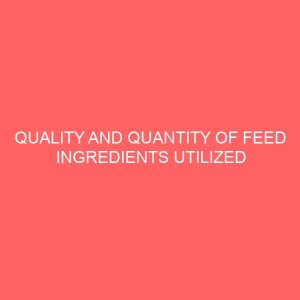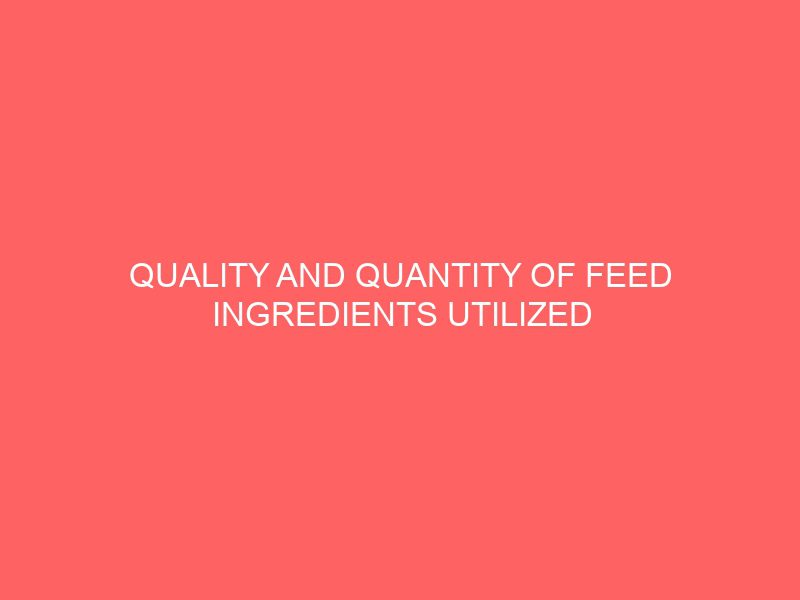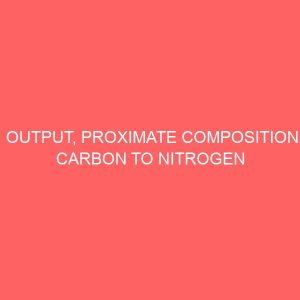Description
CHAPTER ONE
INTRODUCTION
Feeds and feeding is an integral part of pig production that claim between 60-75% cost of production and at the same time dictates the production strength and quality based on the observed feeding regime and feeding quality. Quality and quantity of feed ingredients utilized in feed formulation are the determinant of feed quality. These ingredients could be grouped as main (bulk), supplement (small) or micro (minute) ingredients depending on their inclusion rate. However they are all inevitable for good performance of the animals.
It is of great importance in livestock improvement to supplement for protein and other available nutrients which might be limiting in the diet of the animal. In animal nutrition, the provision of nutrients needed by the animal through supplementation is usually done in accordance to the animal’s requirements.
It is a necessity to supply all the required nutrients by the animal in its diet, but the major limiting factors to achieving this are the sourcing of cheap, available and quality nutrients with the price been the most prominent. The prices of these protein sources have been escalating continuously in recent times, whilst availability is often erratic. The problem has been worsened due to the increasing competition between humans and livestock for these protein ingredients as food. According to Odunsi (2003) the rapid growth of human and livestock population, which is creating increased needs for food and feed in the less developed countries, demand that alternative feed resources must be identified and evaluated.
In high populated countries that are Food-Deficit like Nigeria, surplus of cereals is generally not available; therefore, it is not advisable to develop a wholly grain-based feeding system. The recommended policy is to identify and use locally available feed resources to formulate diets that are as balanced as possible (Guèye and Branckaert, 2002). There is the need, therefore, to explore the use of non-conventional feed sources that have the capacity to yield the same output as conventional feeds, and perhaps at cheaper cost.
Soya bean meal and fish meal have been widely and successfully used as conventional protein sources for livestock but due to the high competition of these food and feed materials between man and animal, they are gradually being replaced with non-convectional protein sources like the moringa leaf meal for the formulation of animal feed.
This strategy could help reduce the cost of production, and ensure cheaper meat production thereby making available the major crops for human consumption. The economization of feed cost using cheaper and unconventional feed resources (Vasanthakumar et al., 1999; Bhatt and Sharma, 2001; Muriu et al., 2002) is an important aspect of commercial pig production.
Recently, there has been interest in the utilization of moringa (Moringa oleifera) commonly called horseradish tree or drumstick tree, as a protein source for livestock (Makker and Becker, 1997; Sarwatt et al., 2002). Moringa leaves have quality attributes that make it a potential replacement for soybean meal or fish meal in non-ruminant diets. Moringa can easily be established in the field, has good coppicing ability, as well as good potential for forage production. Furthermore, there is the possibility of obtaining large amounts of high quality forage from moringa without expensive inputs due to favorable soil and climatic conditions for its growth. Sarwattet al. (2004) reported that moringa foliages are a potential inexpensive protein source for livestock feeding. The advantages of using moringa for a protein resource are numerous, and include the fact that it is a perennial plant that can be harvested several times in one growing season and also has the potential to reduce feed cost. Moringa oleifera is in the group of high-yielding nutritious browse plants with every part having food value (Duke, 1998).
Despite the high crude protein content of moringa leaf meal, there is little information available on the use of this unconventional feed resource, especially as an alternative protein supplement for pig production.
The objectives of the study were to:
Evaluate the chemical content of cultivated, air-dried moringa leaf meal.
Evaluate the chemical content of wet brewers spent grain.
Evaluate feed intake and weight gain of weaner pigs fed diets containing moringa leaf meal and brewers spent grain.







